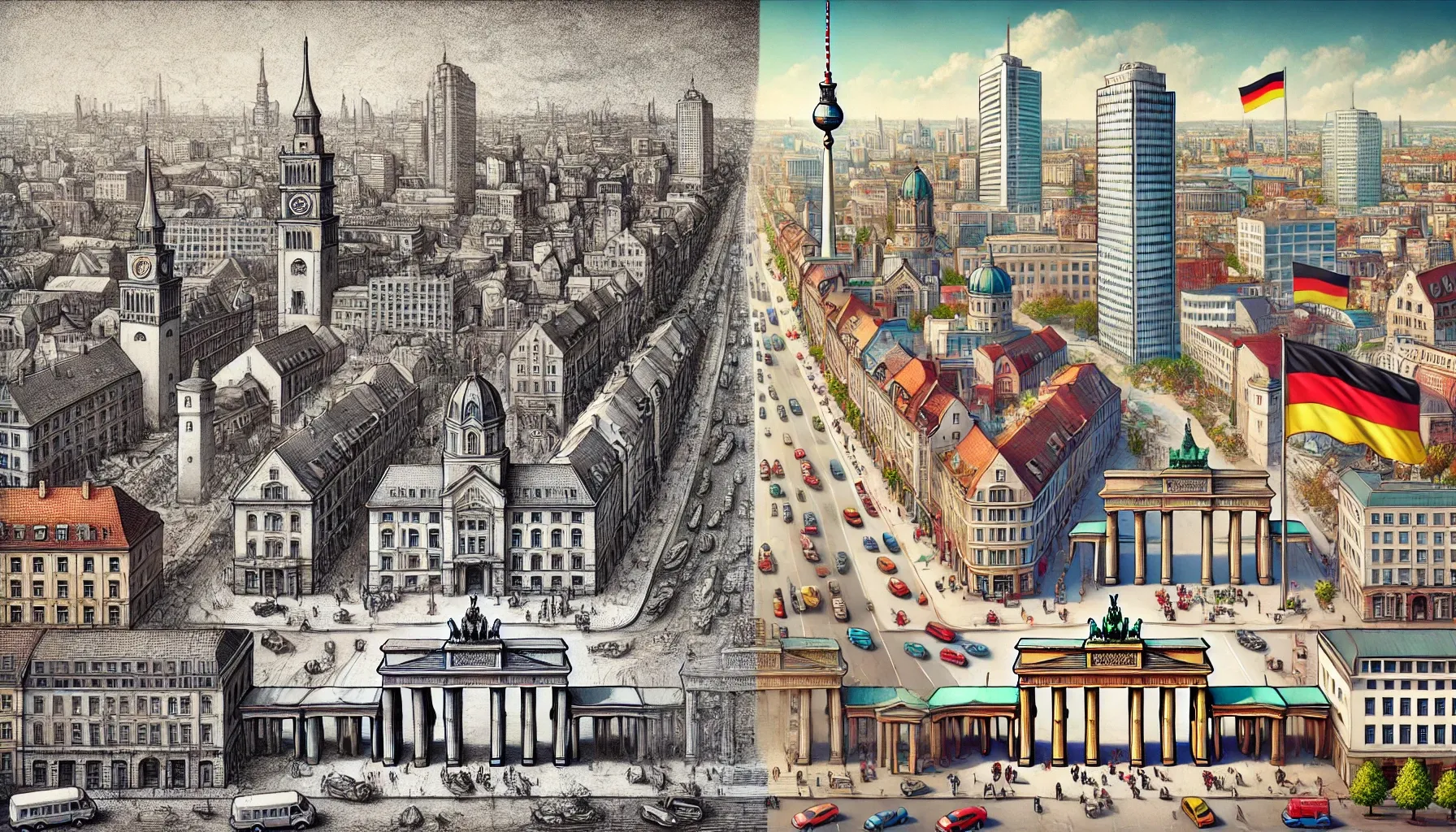What are the differences between East and West Germany today?

- How do modern realities divide Germany into East and West?
- Why is there a stratification in the housing market in Germany?
Historical context of the division of Germany
Until October 3, 1990, Germany existed as two separate states: the Federal Republic of Germany (FRG), also known as West Germany, and the German Democratic Republic (GDR), representing East Germany. Berlin, which served as the capital of both parts, was divided into two parts: East Berlin served as the administrative center of the GDR, while West Berlin was part of the FRG. Today, the terms "old lands" and "new lands" are often used to refer to the respective regions of the country.
Modern views on division
As of today, the citizens of Germany are striving to rid themselves of old stereotypes related to the division of their country into east and west, and to leave behind all painful memories. Nevertheless, three decades after reunification, the differences between the northern and southern parts remain noticeable.
West Germany: Attractiveness for Immigrants
For Russians considering the possibility of moving to Germany, Western Germany is usually seen as more attractive. This is due to:
- a higher standard of living;
- a lot of jobs.
Immigrants often choose large cities like Munich, Hamburg, and Cologne. Due to the well-developed infrastructure, many buyers on the western side of the country are interested in purchasing apartments located close to educational institutions, such as schools and kindergartens.
Eastern Germany: advantages and challenges
Nevertheless, there are those who express a desire to live in the eastern part of the country. The main advantages of the "new lands" include:
- affordable housing prices;
- the presence of quality universities.
People choosing East Germany as their new place of residence are most often looking for apartments in cities like Dresden, Leipzig, or Chemnitz, preferably located near educational institutions.
Economic situation and labor market
The demand for housing in different regions of Germany is determined by both economic indicators and the social situation. It is important to note that Eastern Germany is facing serious challenges:
- the demographic situation here is deteriorating significantly;
- the population is aging faster than in the rest of the country;
- This leads to an increase in the number of retirees and a decrease in the proportion of young people.
Unemployment in the eastern part of the country remains high: in some regions it can reach 17.8%. At the same time, many western regions show lower rates, sometimes not exceeding 6.7%. It is also worth noting that the number of foreign specialists in western Germany is five times greater than in the east.
Industrial base and consumer prices
The industrial base in the "new states" is less developed, and all 30 joint-stock companies represented in the DAX index are located in the west of the country.
The prices of consumer goods in both regions differ insignificantly, but the purchasing power of residents in West Germany is generally higher.
- The average annual consumption in the "old lands" is about 22,000 euros per person.
- In the "new" territories, this figure is lower — less than 19,000 euros.
The difference in income is explained by the inequality: the average salary is 2,525 euros per month in the west and 1,983 euros in the east.
Conclusion
In conclusion, life in West Germany is characterized by plenty of opportunities and a high standard of living, while East Germany attracts those looking for more affordable housing and quality education.
Differences in the housing market in Germany
According to the results of conducted research, the real estate market in Germany shows a clear divide between the western and eastern regions of the country. For example, among young people around the age of 20, there is a noticeable level of unemployment, which, especially in the east, is about 11.78%. Meanwhile, among elderly people over 60, this figure reaches 12.3%.
The average salary in the country is 2525 euros gross; however, rent and property prices in major cities like Munich and Frankfurt am Main are significantly higher than in less developed areas of eastern Germany.
Population migration and future forecasts
Against the background of high unemployment in the east of the country, there is an active migration of people to more economically stable areas in the west. These migration processes lead to an expected increase in the number of households in the west of Germany of up to 7% in the next few years, while in the eastern part of Germany this number will only amount to 2.4%.
According to a study by Deutsche Bank, by 2020, the west will need about 1.5 million new housing units, while the east will only require enough for 500,000.
Difference in ownership
The difference in income also affects the number of residential properties in private ownership. According to data from Postbank, in the western part of Germany, the share of homeowners is 48%, while in the eastern part, it is only 38%.
Thus, in the old lands, almost every second resident owns their own home, while in the new lands, the ratio is about 1 to 3.
29 September
9 October 2024
29 January
9 October 2024
Cities with economies in the East comparable to the West
Despite the general trends, there are also cities in eastern Germany whose level of economic development is quite comparable to the western regions. These cities include:
- Dresden
- Yen
- Leipzig
- Potsdam
The cost of housing in major West German cities is significantly higher than in the East, with apartment rentals being about 1.5 times more expensive. The top ten most expensive cities in the country are located in the "old lands," including Munich, Stuttgart, Düsseldorf, and Hamburg.
Invisible boundaries and stereotypes
The news agency Immobilienverband Deutschland notes the existence of an invisible border even within Berlin, where the average price per square meter in the western part of the city is 1500 euros, while in the eastern part it is 1400 euros.
Many believe that East Germany is filled with panel buildings constructed during the Soviet era. However, in addition to such structures, the eastern regions also offer modern and high-quality options. For example, in areas of Leipzig like Stötteritz and Lindenau, there is good housing built in the late 19th to early 20th century. The average rental price in these buildings ranges from 4 to 5 euros per square meter, excluding utilities.
Comparison of rental rates
In the western part of the country, for the same amount, you can only find an apartment in poor condition, for example, in Gelsenkirchen. Overall, rent in Western Germany will cost about 9 euros per square meter per month, while in the east, this figure is only 6 euros.
Thus, differences in rents and living standards between the two parts of Germany continue to have a significant impact on migration processes, shaping a variety of social and cultural conditions. In conclusion, the real estate market and living standards in Germany vary greatly from region to region.

Conclusion
Having analyzed the dynamics of life in the two parts of unified Germany, I concluded that both West and East Germany have their unique characteristics that make each of them attractive in their own way. The division of the country in the past, despite the reunification, is still felt in various aspects – from economic prosperity to the standard of living.
In the West, the infrastructure is undoubtedly better developed and there are more job opportunities.High income levelThe local population provides comfortable living and growth conditions. However, if we look at East Germany, we can see a potential that is gradually unfolding: it offers not only more affordable housing and rental prices but also prestigious universities that attract students and young talents.
Comparison of two regions
It is also important to note that there is still a significant difference in the demographic situation and unemployment levels between the two regions. The increasing migration from East Germany to West Germany reflects these disparities. However, it is worth remembering that there are promising cities in the eastern part of the country that have every chance of further development and attracting new residents.
Key findings about the regions:
- West Germany:High standard of living, a variety of job opportunities.
- East Germany:More affordable housing prices, the presence of good universities, and growing potential.
In short, when considering a move to Germany, it's important to look at not only the traditional "old lands" but also the "new" regions that offer their own advantages. Ultimately, the choice of residence should be determined not only byeconomic indicators, but alsopersonal preferencesandlife circumstancesOur country is focused on the future, and each region can offer something unique for those looking for a new place to live. The reunification of Germany has opened new horizons, and there are opportunities for growth and prosperity here for everyone who is ready to move forward.
Comment
Popular Posts
29 September
375
9 October 2024
1485
9 October 2024
9940
Popular Offers

Subscribe to the newsletter from Hatamatata.com!
Subscribe to the newsletter from Hatamatata.com!
I agree to the processing of personal data and confidentiality rules of Hatamatata














